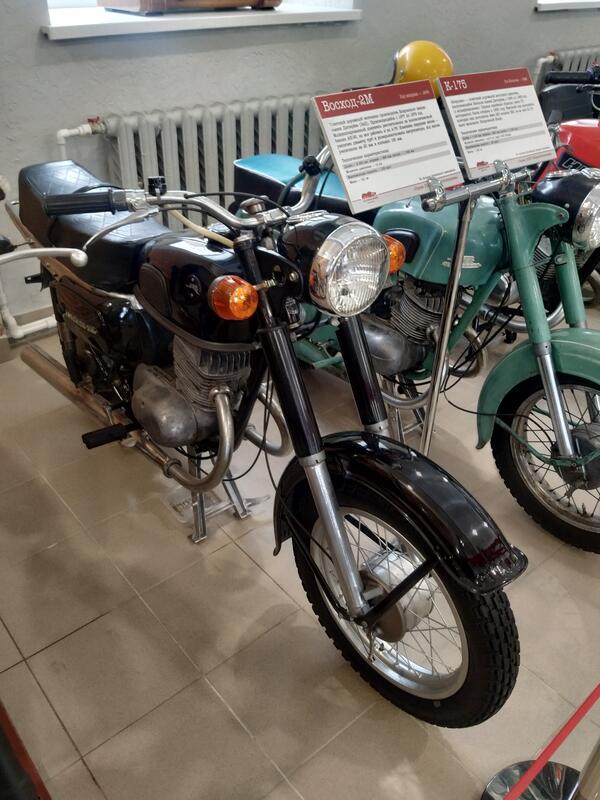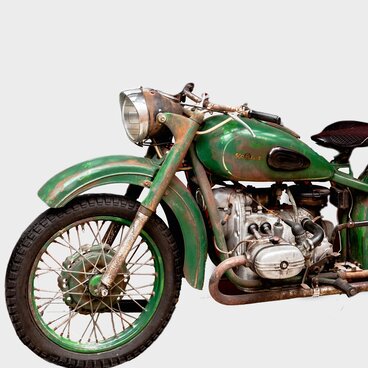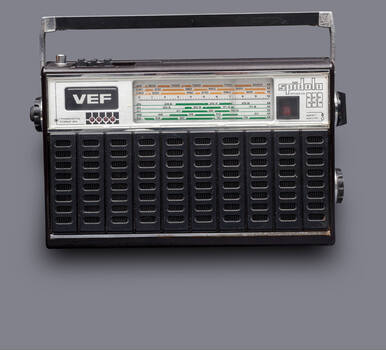The Soviet on-road motorcycles of the Voskhod brand appeared in the product range of the Degtyaryov Plant (ZiD) in Kovrov in the mid-1960s. In fact, it succeeded the earlier K-175 Kovrovets series that was produced in the Soviet Union between 1957 and 1965.
The Voskhod motorcycles won recognition from the public. Although inexpensive, they were highly reliable and perfectly suited for both paved roads and off-road conditions. These motorcycles rarely showed any defects or malfunctions.
In 1972, the first Voskhod-2 was produced. When designing this model, the engineers decided not to change the frame. They improved the appearance by using new optics, changing the shape of turn signals from rectangular to round, and mounting a new luggage rack, and mudguards. The maximum speed remained at the level of 95 km/h.
In 1976, the new Voskhod-2M motorcycle was presented. It had very few differences compared to its predecessor, apart from being slightly larger and having a different tail light. The Voskhod-2M (1976–1979) was equipped with a new engine. The power was increased from 10.5 to 14 hp at 5,500–5,800 rpm. The engine’s capacity remained at the level of 173.7 cc. By late 1977, the plant had produced the first series of 89 motorcycles.
The new engine was designed to run on the AI-93 gasoline with a high octane rating but could also operate using the A-76 fuel. The motorcycle had a modified front fork with an increased pipe diameter and improved shock absorbers.
The Voskhod-2M motorcycle could reach a maximum speed of 105 km/h which was 10 km/h faster than the speed of the Voskhod-2. The motorcycle’s dry weight amounted to 121 kg. To accelerate to 60 km/h, the bike took only 8 seconds. The motorcycle could run up to 500 or 600 kilometers continuously on one tank of gas, thus allowing the owners to undertake longer trips.
By the time this model was discontinued, the Degtyaryov Plant had reached the levels of the daily production of 1,050 motorcycles. In 1979, it started assembling the new Voskhod-3 motorcycles. The successor received a new fuel tank, an updated intake system, and shock absorbers.
The Voskhod motorcycles won recognition from the public. Although inexpensive, they were highly reliable and perfectly suited for both paved roads and off-road conditions. These motorcycles rarely showed any defects or malfunctions.
In 1972, the first Voskhod-2 was produced. When designing this model, the engineers decided not to change the frame. They improved the appearance by using new optics, changing the shape of turn signals from rectangular to round, and mounting a new luggage rack, and mudguards. The maximum speed remained at the level of 95 km/h.
In 1976, the new Voskhod-2M motorcycle was presented. It had very few differences compared to its predecessor, apart from being slightly larger and having a different tail light. The Voskhod-2M (1976–1979) was equipped with a new engine. The power was increased from 10.5 to 14 hp at 5,500–5,800 rpm. The engine’s capacity remained at the level of 173.7 cc. By late 1977, the plant had produced the first series of 89 motorcycles.
The new engine was designed to run on the AI-93 gasoline with a high octane rating but could also operate using the A-76 fuel. The motorcycle had a modified front fork with an increased pipe diameter and improved shock absorbers.
The Voskhod-2M motorcycle could reach a maximum speed of 105 km/h which was 10 km/h faster than the speed of the Voskhod-2. The motorcycle’s dry weight amounted to 121 kg. To accelerate to 60 km/h, the bike took only 8 seconds. The motorcycle could run up to 500 or 600 kilometers continuously on one tank of gas, thus allowing the owners to undertake longer trips.
By the time this model was discontinued, the Degtyaryov Plant had reached the levels of the daily production of 1,050 motorcycles. In 1979, it started assembling the new Voskhod-3 motorcycles. The successor received a new fuel tank, an updated intake system, and shock absorbers.





